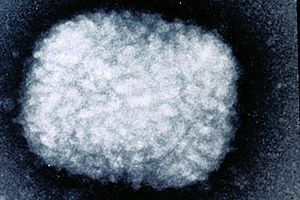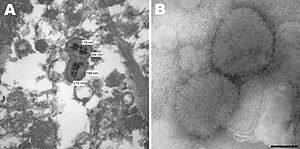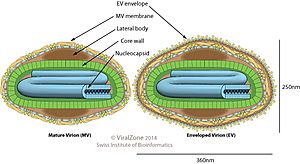Poxviridae facts for kids
Quick facts for kids Poxviridae |
|
|---|---|
 |
|
| Virus classification |
|
| (unranked): | Virus |
| Family: | Poxviridae |
| Subfamilies | |
The Poxviridae are a family of viruses that have DNA as their genetic material. They are known for causing diseases that often lead to skin "poxes" or bumps. These viruses naturally infect both animals with backbones (like humans) and arthropods (like insects). There are currently 83 known types of viruses in this family. They are grouped into 22 different kinds, which are then split into two main subfamilies. One of the most famous diseases caused by a poxvirus is smallpox.
Four main groups of poxviruses can infect humans:
- Orthopox: This group includes the smallpox virus (called variola), vaccinia virus, cowpox virus, and monkeypox virus.
- Parapox: Viruses like orf virus and pseudocowpox belong here.
- Yatapox: This group includes tanapox virus.
- Molluscipox: The molluscum contagiosum virus (MCV) is in this group.
The vaccinia virus (often seen in India) and molluscum contagiosum are common. Monkeypox infections are also increasing, especially in parts of Africa. It's important to know that chickenpox is NOT a true poxvirus. It's actually caused by a different virus called varicella zoster, which is a herpesvirus.
Contents
What's in a Name?
The name Poxviridae comes from the word "pox." This word was used for diseases that caused bumps or sores on the skin. In the past, viruses were grouped based on these visible signs. Today, scientists classify viruses in a more detailed way. They look at things like the virus's shape, its genetic material (DNA or RNA), how it makes copies of itself, what animals it infects, and the type of disease it causes. The smallpox virus is still the most well-known member of this virus family.
A Look Back in Time
Diseases caused by poxviruses, especially smallpox, have been around for a very long time. One of the earliest suspected cases was the Egyptian pharaoh Ramses V. He might have died from smallpox around 1150 BCE (over 3,000 years ago!). Smallpox is believed to have spread to Europe around the 700s and then to the Americas in the early 1500s. When it reached the Americas, it caused the deaths of 3.2 million Aztecs in just two years. This happened because people in the Americas had never been exposed to the virus before.
About 100 years after Edward Jenner discovered that the milder cowpox could protect people from the deadly smallpox, a global effort began. The goal was to vaccinate everyone against smallpox and get rid of the disease completely. The last natural case of smallpox happened in Somalia in 1977. After two years of searching, no more cases were found. In 1979, the World Health Organization (WHO) officially declared smallpox gone from the world.
Today, all smallpox virus samples are kept in only two special labs. One is in Atlanta, Georgia, USA, and the other is in Moscow, Russia. After the events of September 11, 2001, governments became more worried about smallpox being used in bioterrorism. However, some poxviruses are now being studied for their potential to help treat different human cancers.
How Poxviruses Work
Virus Structure
Poxvirus particles, called virions, are usually covered by an outer layer, like an envelope. They come in different shapes depending on the specific type, but many look like a brick or a rounded oval. This shape comes from how they are wrapped inside the host cell. These virus particles are very large compared to other viruses. They are about 200 nanometers wide and 300 nanometers long. For comparison, a common cold virus (Rhinovirus) is only about one-tenth the size of a poxvirus. Each poxvirus carries its genetic information in a single, long piece of DNA.
How They Make Copies
The process of a poxvirus making copies of itself involves several steps.
- First, the virus attaches to a special spot on the surface of a host cell.
- Then, it enters the cell. The virus sheds its outer layer as it enters.
- Next, the virus releases its core (the part with its DNA) into the cell's cytoplasm.
- Poxviruses have their own special tools to copy their DNA and make proteins. This is unusual because most DNA viruses use the host cell's tools, which are usually found in the cell's control center, the nucleus. But poxviruses do all their copying in the cell's cytoplasm (the jelly-like substance inside the cell).
- After the virus DNA is copied, new virus particles are built inside the cell. This is a complex process that scientists are still studying.
- Finally, the new virus particles leave the cell, often causing the host cell to die. This whole process can happen quite quickly, in about 12 hours.
Virus Families
The Poxviridae family is divided into two main subfamilies:
- Chordopoxvirinae: These viruses infect vertebrates (animals with backbones).
- Entomopoxvirinae: These viruses infect insects.
There are many different groups (called genera) within these subfamilies. Scientists are always discovering new viruses, so new groups might be added in the future.
Chordopoxvirinae
- Avipoxvirus
- Capripoxvirus
- Centapoxvirus
- Cervidpoxvirus
- Crocodylidpoxvirus
- Leporipoxvirus
- Macropopoxvirus
- Molluscipoxvirus
- Mustelpoxvirus
- Orthopoxvirus
- Oryzopoxvirus
- Parapoxvirus
- Pteropopoxvirus
- Salmonpoxvirus
- Sciuripoxvirus
- Suipoxvirus
- Vespertilionpoxvirus
- Yatapoxvirus
Entomopoxvirinae
- Alphaentomopoxvirus
- Betaentomopoxvirus
- Deltaentomopoxvirus
- Diachasmimorpha entomopoxvirus
- Gammaentomopoxvirus
Vaccinia Virus
The vaccinia virus is a very important poxvirus. It's famous because it was used to create the vaccine that helped get rid of smallpox. Scientists also use vaccinia virus as a tool to study other viruses and to develop new vaccines. It's good for this because it causes a strong immune response in the body.
Vaccinia virus usually enters cells by fusing with them. Once inside, it copies its DNA and builds new virus particles in the cell's cytoplasm. These new particles then go through several steps to get their outer layers and prepare to leave the cell. They travel along tiny "roads" inside the cell to reach the edge, where they can then be released.
See also
 In Spanish: Poxviridae para niños
In Spanish: Poxviridae para niños
- Quokkapox virus
- Water warts
Images for kids





